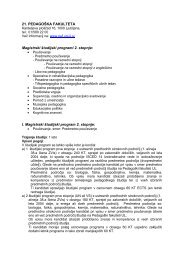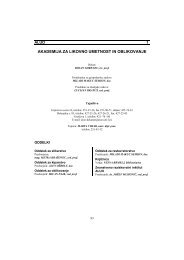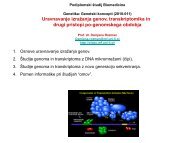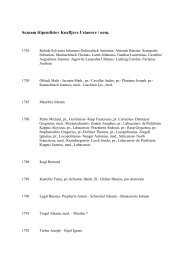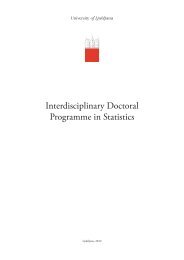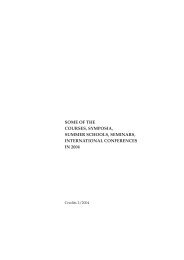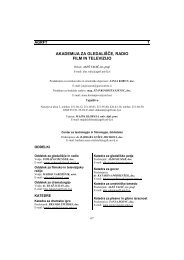Medicinska fakulteta Univerze v Ljubljani 1919–1945 - Univerza v ...
Medicinska fakulteta Univerze v Ljubljani 1919–1945 - Univerza v ...
Medicinska fakulteta Univerze v Ljubljani 1919–1945 - Univerza v ...
You also want an ePaper? Increase the reach of your titles
YUMPU automatically turns print PDFs into web optimized ePapers that Google loves.
The Chair of Medical-Surgical<br />
Studies at the Ljubljana Lyceum<br />
1791–1848<br />
I<br />
From the middle of the 18 th century, the freedom of academic<br />
instruction and science began to increasingly establish itself at<br />
the provincial universities of the northern and western German<br />
states, while in Austria, they knew of the weaknesses of their<br />
tertiary education as early as the time of Charles VI (1711–1740)<br />
when they began the first hesitant attempts to remedy them, but<br />
unfortunately, there were no major changes to the educational<br />
system� The first measures only signalled a stronger influence of<br />
the state� The more meaningful interventions into the educational<br />
system that were implemented during the reign of Maria<br />
Theresa (1740–1780), Joseph II (1780–1790) and Leopold II<br />
(1790–1792) could already be seen as a gradual creation of a new<br />
educational and study concept� The complex reform activities,<br />
which were already strongly influenced by the ideas of the Age<br />
of Enlightenment, focused primarily on ensuring a stronger state<br />
influence, practical vocational fields of study and the elimination<br />
of denominational fields of study� The attempts at adopting and<br />
connecting with the study programmes and study systems of<br />
Western Europe were, however, unsuccessful� The University<br />
of Vienna, which began establishing itself as a model Austrian<br />
university, was at the centre of reform efforts, but educationalpolitical<br />
orientations were nevertheless being conceptualised for<br />
the entire country�<br />
During the first phase of university reform, the Theresian reform<br />
absolutism assisted by the personal physician of the Empress<br />
and the central personality of Theresian reform, the Dutchman<br />
Gerard van Swieten, managed – in less than a decade – to significantly<br />
weaken the monopolistic position that was enjoyed up to<br />
that time in tertiary education by the Order of the Jesuits� Thus<br />
began the process of limiting their educational autonomy� The<br />
positions, from which Jesuits were deposed, were taken up by the<br />
state that appointed their own personnel resources�<br />
The first reforms of university-level studies resulted in students<br />
storming the universities seated in large cities where the majority<br />
of public offices were located and where the main civil legal and<br />
other matters were being conducted and arranged� This primarily<br />
applies to Vienna and Prague, i�e� the two higher education<br />
schools that had been operating four faculties for a long time:<br />
the Faculty of Philosophy, Faculty of Law, Faculty of Medicine<br />
and the Faculty of Theology; where the fields of study were<br />
already regulated� Those who passed the prescribed examina-<br />
97<br />
Jože Ciperle<br />
tions, especially the law students, could be optimistic about<br />
getting a suitable job� After the 1850s, the system of examinations<br />
and professional qualifications gradually became increasingly<br />
more interdependent and interconnected� The old system of job<br />
recruitment that was based on personal connections was replaced<br />
by the new system that relied on effectiveness� In opposition to<br />
the expectations of the higher education system reformers, the<br />
changes to academic study – at least in the large university cities<br />
where the conditions in the area of employment were thoroughly<br />
changed on account of the rise of new professions – brought<br />
about an increase in the number of students, which occurred<br />
from the 1850s�<br />
Things were different at the numerous colleges or higher education<br />
teaching institutions in the provinces� Possibilities for study there<br />
were more modest and limited primarily to philosophy and<br />
theology� They mostly served regional needs, while state-decreed<br />
measures reached them relatively late� They were a thorn in the<br />
side of the enlightened reformers of higher education in Vienna<br />
who saw them as centres of the scorned ecclesiastical orders<br />
and Scholasticism� Because the new disciplines there were only<br />
sparsely represented, the number of suitably trained professors<br />
was limited and the number of students small; they were of the<br />
opinion that “there would be no harm if they were to be abolished<br />
as soon as possible”� Even more so because similar meditations<br />
were springing up in Germany, which were supported by the<br />
argument that two universities were sufficient even for all of<br />
England�<br />
In the second phase of university reform that began in 1772,<br />
when the abolition of the Order of the Jesuits was beginning<br />
to be intimated, Austrian universities were to a large extent<br />
transformed – alongside the extinguishment of their authority<br />
and their character of autonomous corporations at the time –<br />
into educationally organised institutions, i�e� a sort of “vocational<br />
schools” for the upbringing of loyal servants of an absolutist<br />
state, which included future clergy, lawyers, public servants and<br />
doctors� The conversion of Jesuit universities into state institutions<br />
suited the bureaucratic state administration� The state<br />
took into its own hands “study” at the four university faculties,<br />
the property owned by the university as well as the jurisdiction<br />
enjoyed by the university�<br />
In the beginning of the 19 th century, there were much greater<br />
opportunities for the acquisition of academic education as a



